

 |
DOES IT NEVER STOP?!? |  |
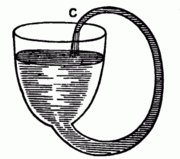 Robert Boyle's perpetual syphon! Robert Boyle's perpetual syphon! |
Back in 1966, the great physicist Richard Feynman was asked by some Caltech students to come and look at a wonderful new automobile engine. It would run for 6 months on a single injection of a small amount of secret fuel directly into the cylinders. Wowieee! Feynman immediately knew he was being asked to look at a current incarnation of the perennially popular perpetual motion machine, which has been with us continuously in ever-changing forms and aspects since about 1600. Despite all the progress in physics and all of the explosive growth of our knowledge of the universe and its processes since 1600, the pre-scientific con-games played with perpetual motion show no signs of slacking off. |
|
When he got to the parking lot where the running engine was on display, Feynman immediately noticed that the “engine” seemed to be essentially an electric motor, and that a bunch of largely useless “test equipment” sat between the machine and the spectators, with a large, businesslike power cord “for the equipment” running to an outlet on the side of the building. The “inventor,” noting Feynman's suspicions, pulled the plug to demonstrate that “this cord has nothing to do with the engine.” Of course, almost at once, the “inventor” started to insert the plug again. Feynman asked to hold it, and continued to hold it until the “inventor,” nervously eyeing his engine, became frantic. When Feynman finally released the extension cord, the ”inventor” jammed it into the outlet. The engine promptly exploded, killing one spectator and seriously injuring two others! The “inventor” sued Feynman for “ruining his engine,” collected some money in an out-of-court settlement, and he and his revolutionary technology were never heard from again. It's an old story, literally 400 years old... only the power cord is new. Charles Redheffer's mysterious machine, exhibited in Philadelpha in the early 1800s, was exposed by steam-engine pioneer Robert Fulton, who tore away partitions to reveal an abused-looking old man listlessly turning a crank in an adjacent room. |
Leonardo's Unbalanced Weights?  |
A study of the history of the crackpots and con-men who have kept the torch of perpetual motion burning in the hearts of gullible investors for nearly four centuries reveals a broad spectrum, indeed.
There are legitimate machines with sources of power that we tend to take for granted, and not notice, such as the perpetual clock developed by James Cox in the 1760s. This clock was wound by changes in atmospheric pressure, and is no more a perpetual motion machine than is a windmill or a waterwheel. Impractical but functional machines have been devised that are powered by a wide range of natural processes, everything from chemical reactions inside a potato to the warping of green wooden boards exposed to the environment.
Getting to the true ``perpetual motion'' exhibits, we find many examples of machines with cleverly-hidden sources of power, such as the “Wheel of Orffyreus,” shown by Johann Bessler in early 18th Century Germany, and the wonderful motors exhibited by John Keely in the late 19th Century in Philadelphia. Bessler's wheel was driven by concealed clockwork, which kept two clearly visible compound pendulums swinging, and they in turn drove his wheel. (Alas, the little hired girl, one of whose jobs it was to wind the hidden clockwork regularly, ran away from Bessler and revealed his secret to officials.) Keely's machines were powered by compressed air delivered by tubes disguised as spokes and supports. Battery power is currently the most popular hidden source; hey, it's as close as the nearest drug store, and modern batteries are small and easy to conceal.
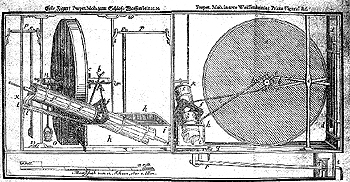
|
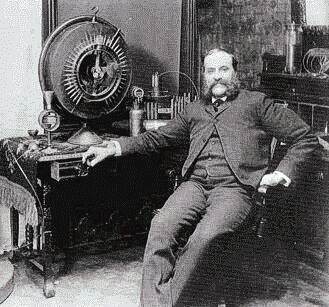
|
Then there are machines which involve a closed cycle for water, ammonia, freon, air or some other fluid, and the machine is supposed to operate all by itself, drawing energy from the fluid, and never needing anything else. To see the problems with this, imagine a water wheel or turbine that pumps the water that spins it back up to its original level so it can spin the wheel again, as first proposed back in 1618 by Robert Fludd and as still being sold to Texan investors by Arnold Burke as late as 1980.
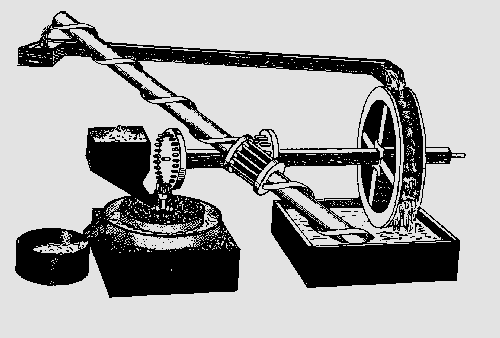
When water, or any other substance, goes through a cycle of this kind, the kinetic and potential energies it possesses as a whole decrease irreversibly, while the kinetic and potential energies of each pair of molecules or atoms relative to one another increase irreversibly. In short, the substance irreversibly loses the ability to do work. As a result, the fluid--- no matter what it is, as long as it is matter--- cannot be made to circulate... unless it has a little help. Burke's machine was found to have a concealed water pump, powered by a battery pack hidden under a nearby bed. The next time you accidentally drop something onto the floor, hold your hand exactly where it was when the object fell out, and try to coax the object to jump spontaneously from the floor back into your hand. You'll get a bit of insight of the universal framework of nature that these “inventors” claim to have somehow set aside.

|

|
Imagine that an “inventor” comes to you with the following great idea. He has a machine that runs on ordinary water. A “secret catalyst” breaks the water into separated hydrogen gas and oxygen gas, which are then burned back to water in the cylinders of a piston engine, and the water is endlessly recycled. The catalyst is unaffected and can be reused indefinitely. “Why, the engine can run a thousand years on a little cupful of water, son! All I need is $10,000 from you, for some spare parts.” Would you invest? About 30 years ago, the former owner of a large rent-a-car chain invested millions in just such a scheme... against the advice of every expert he consulted. What do you think happened to those millions?
With 400 years worth of cons to ponder, investors still haven't learned their lessons. In fact, they don't seem to recognize that there is a lesson. About two decades ago, the British science magazine New Scientist commissioned the construction of a classic perpetual motion machine, with a very-well-concealed conventional source of power. The machine was exhibited all over the British Isles as part of a contest and promotion for the magazine. Spectators were challenged to guess the nature of the hidden power source without being allowed to touch the machine, which was on a pedestal, protected by a transparent plastic case. New Scientist staff members were horrified, as they mingled with the spectators, to find many telling their children or wives that the perpetual motion machine was a new discovery and actually worked.
On the next page, we'll learn just why a working perpetual motion machine is precisely as rare as a day of 24 hours that is followed by a day of 2.4 hours that is followed by a day of 240 hours.
For convenient Internet writeups on perpetual motion machines and their generally crazed or ignorant inventors, click Phact, or Jim Loy, or Bob, or Unworkable Devices Museum or Perpetuum, or Leonardo and Leupold, or History of Perpetual Motion Machines. The Minato “Motor” Notes for a college course on perpetual motion versus physics.
This material was originally published in the Internet magazine Baudeville in 1995.
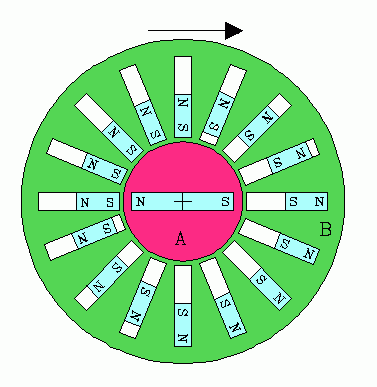
“Unbalanced wheels” using permanent magnets became popular about 2 centuries ago, when manufactured permanent magnets became readily available; the most recent well-known version of such an impossible wheel is due to a Japanese musician. |
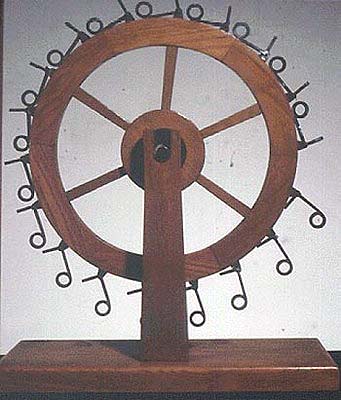
The most famous “unbalanced wheel” was analyzed correctly by thinkers such as Leonardo and Leupold centuries ago. Using simple “lever arm” concepts, they could show that the wheel is actually balanced in any orientation. |